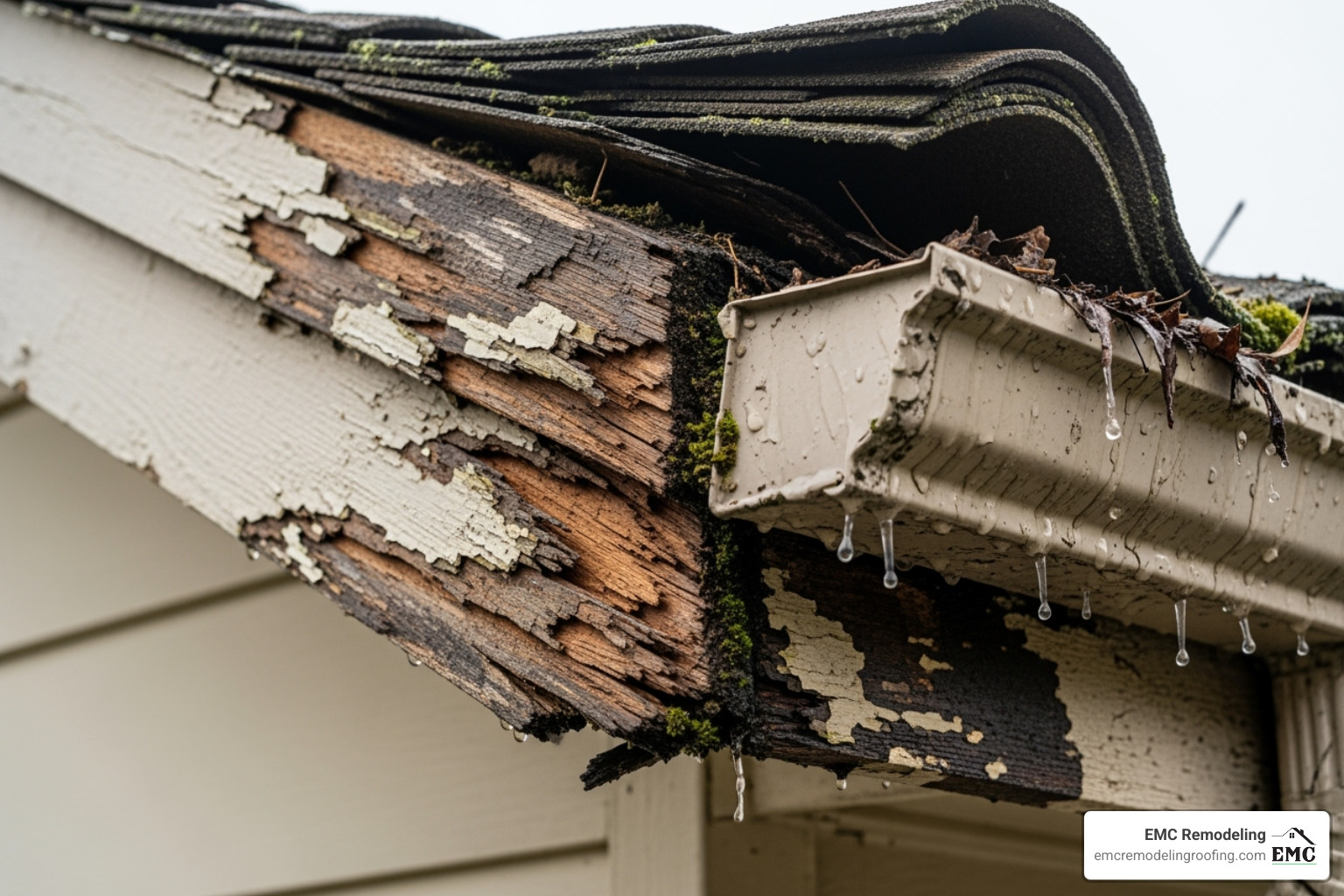Your Roof’s First Line of Defense: Understanding Eaves
Proper roof eaves repair is essential for protecting your home from water damage, foundation issues, and costly structural problems. As a leading provider of comprehensive roofing services in Central Texas, we know these overhanging edges of your roof direct thousands of gallons of rainwater away from your walls and foundation annually. When they fail, the damage spreads fast.
Quick Repair Guide:
- Minor damage: Clean area → Apply wood filler → Sand → Prime and paint
- Major damage: Remove damaged sections → Replace rotted lumber → Seal joints → Professional assessment recommended
- Cost: $300-$1,000 for typical repairs
- When to call pros: Widespread rot, structural damage, or safety concerns
What exactly are eaves? They’re the part of the roof that overhangs the walls, made up of three key components:
- Fascia: The vertical board where gutters attach.
- Soffit: The horizontal underside that provides ventilation.
- Rafter tails: The extending roof frame members.
Without functional eaves, water can seep into walls, rot wood, and create a breeding ground for mold. Ignoring the problem can turn a repair costing $300 to $1,000 into thousands in structural damage.
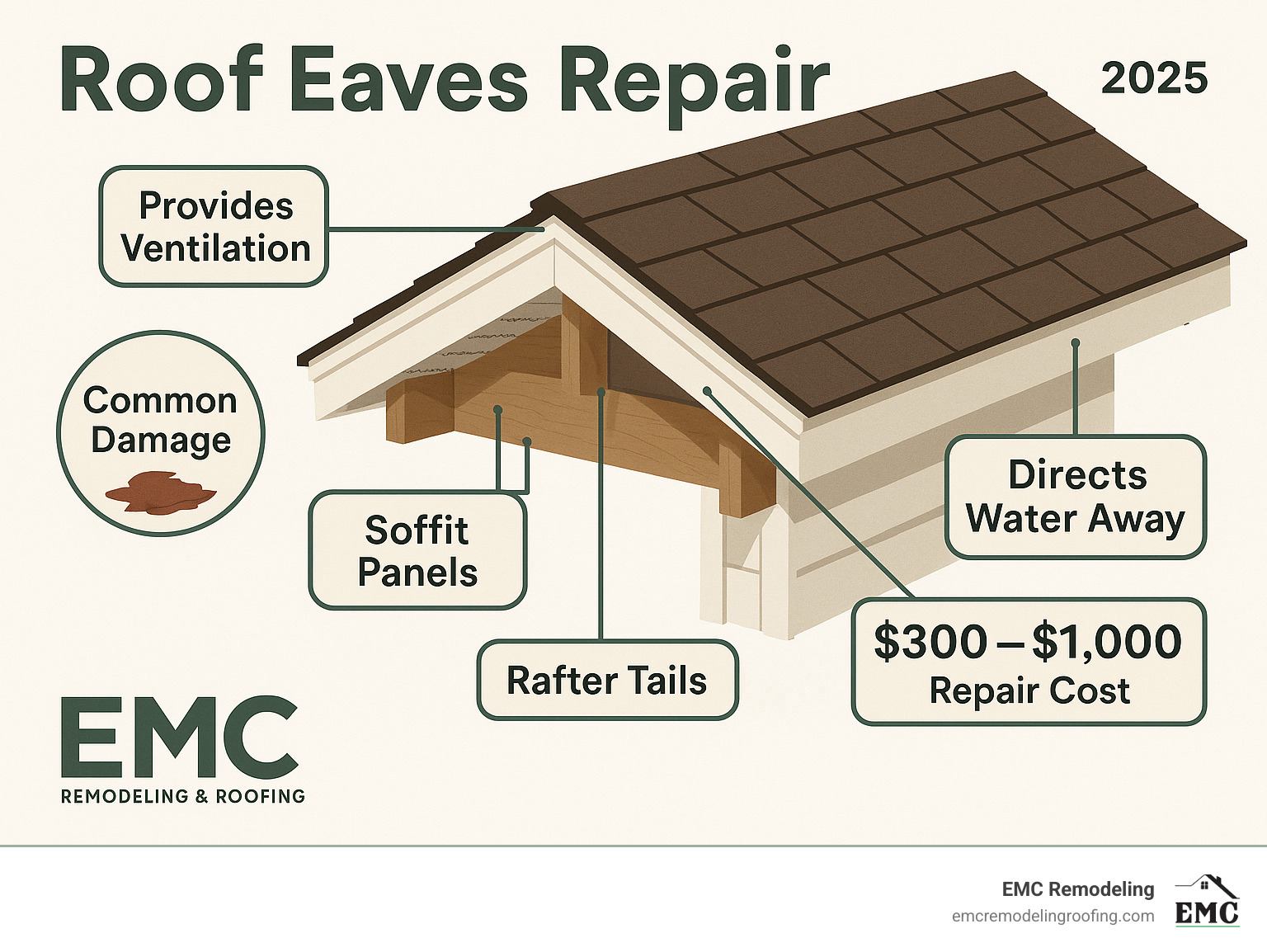
Roof eaves are a critical part of your home’s exterior. Their primary purpose is to manage water flow, channeling rain and snowmelt away from your siding and foundation. This function prevents soil erosion and water intrusion into your basement, saving you from costly foundation repairs.
Eaves also play a crucial role in ventilation. Soffit vents regulate attic airflow, preventing moisture buildup that leads to mold and wood rot. Proper ventilation stabilizes attic temperatures, which helps prevent ice dams in winter and reduces heat buildup in summer, improving energy efficiency. While functional, eaves also provide a finished look to your home’s exterior. Understanding these components is key to effective roof eaves repair.
Spotting the Trouble: 7 Signs Your Eaves Need Attention
Your eaves are often the first part of your home to show signs of distress. Catching these early warning signals can save you from costly repairs down the road.
- Water Damage: Look for brown or yellow stains on exterior walls or on interior ceilings and walls near the roofline. This indicates your eaves are failing to direct water away properly.
- Peeling Paint: Paint peeling from your fascia or soffit is a clear sign of underlying moisture that needs to be addressed.
- Visible Rot or Crumbling Wood: If the wood around your eaves feels soft, spongy, or crumbles when probed with a screwdriver, you have rot that can spread quickly.
- Pest Infestations: Squirrels, birds, or insects nesting in your eaves can cause significant damage by chewing through wood and creating entry points for water.
- Clogged Gutters: Overflowing or sagging gutters force water directly onto your eaves, leading to saturation and damage. Ice dams in winter are another sign of this issue.
- Sagging Sections: A visible dip or sag in the eave line indicates that the supporting wood structure is weakening and requires immediate attention.
- Mold or Mildew Growth: The presence of mold or mildew points directly to a persistent moisture problem that can pose health risks and requires professional assessment.
If you notice any of these signs, especially after severe weather, it’s crucial to investigate further. Understanding the components of your eaves is key to effective repair.
Common Culprits Behind Eave Damage
Understanding why eaves fail helps prevent future issues. Damage is often caused by a combination of factors:
- Weather Exposure: Constant exposure to rain, snow, UV rays, and wind wears down materials over time.
- Water Infiltration from Gutters: Clogged gutters are a primary cause of eave damage, as overflowing water soaks the fascia and soffit. A missing or poorly installed drip edge worsens this problem.
- Pest Damage: Termites, carpenter ants, and other pests create tunnels and holes that weaken the wood and allow water to penetrate.
- Improper Roof Ventilation: Blocked soffit vents trap moisture in the attic, leading to condensation and rot from the inside out.
- Aging Materials: Over time, wood becomes brittle, fasteners loosen, and protective coatings fail as part of their natural lifecycle.
- Poor Initial Installation: Inadequate sealing, improper material choices, or other shortcuts during construction create weak spots that fail prematurely.
The High Cost of Neglect: Why You Shouldn’t Wait
Postponing roof eaves repair can lead to severe consequences. What starts as a minor issue can quickly escalate.
- Structural Damage Risk: Failing eaves compromise the support at your roof’s edge, potentially affecting the entire roofing system. A small repair can turn into thousands of dollars in structural work.
- Increased Repair Costs: Water damage spreads rapidly through building materials. The average repair cost ranges from $300 to $1,000 for typical issues, but neglect can push costs much higher.
- Attic and Interior Leaks: Damaged eaves provide a direct path for water into your attic, where it can ruin insulation, damage drywall, and create electrical hazards.
- Health Hazards from Mold: Persistent moisture creates an ideal environment for mold and mildew, which can spread throughout your home and pose serious health risks.
Addressing eave problems promptly is a smart investment in your home’s longevity and safety.
The Step-by-Step Guide to DIY Roof Eaves Repair
For minor damage, roof eaves repair can be a manageable DIY project. However, safety must be your top priority.
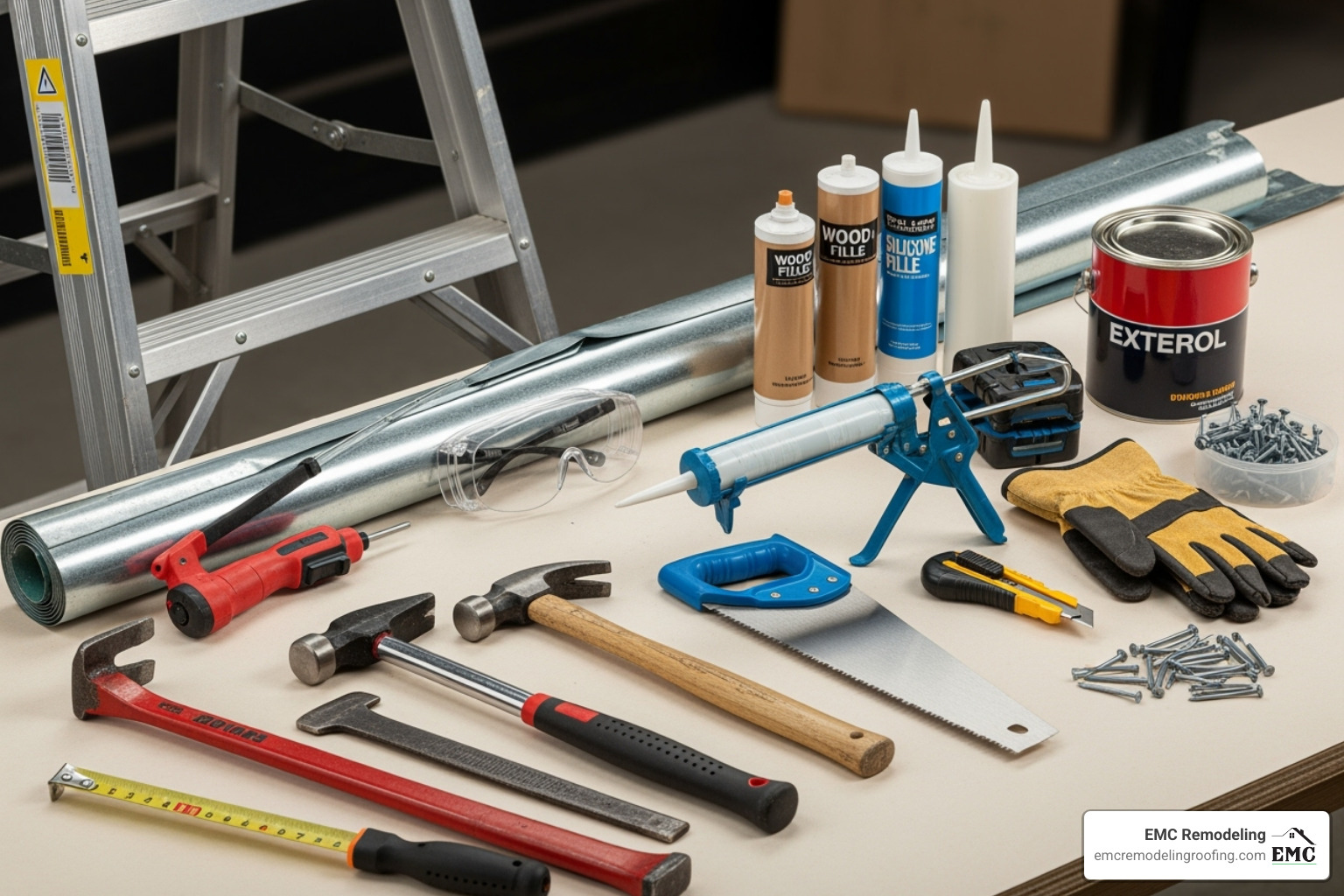
Before you begin, gather your tools and materials. You will need safety gear (sturdy ladder, safety glasses, work gloves, dust mask), tools (pry bar, hammer, drill, saw, utility knife, measuring tape, caulk gun), and materials (pressure-treated lumber, wood filler or epoxy, waterproof silicone caulk, exterior primer and paint, and galvanized nails or screws).
Safety First!
Always place your ladder on firm, level ground, extending it at least three feet above the eave line. A spotter is highly recommended. Wear your protective gear—safety glasses, gloves, and a dust mask—to protect against debris, splinters, and potentially moldy materials. Check for electrical wires near your work area; if you see any, call an electrician. Only work on dry, calm days to avoid accidents.
How to Handle Minor Eave Damage
For small issues like minor rot or cracks, follow these steps:
- Clean and Prepare: Use a stiff brush to remove loose paint and debris. Scrub any mold with a 1:3 bleach-to-water solution. Probe for soft spots with a screwdriver and remove all rotted wood until you reach solid material.
- Fill and Seal: Apply wood filler or epoxy to small holes, slightly overfilling the area. Use waterproof silicone caulk for fine cracks, smoothing it with a wet finger.
- Sand and Finish: Once dry, sand the repaired area until it is smooth and flush with the surrounding surface.
- Prime and Paint: Apply a quality exterior primer, followed by at least two coats of paint to match your eaves and protect the repair from the elements.
How to Tackle Major Eave Replacement
Extensive rot or structural damage is a more complex project, often requiring two people. For additional guidance, you can consult resources on How to Repair Leaking Roof Eaves.
- Remove Damaged Materials: Gently pry up the shingles and drip edge over the affected area. Then, remove the rotted fascia and soffit panels.
- Cut Away Rotted Rafter Tails: Use a saw to cut back to solid, healthy wood. For extensive rot, you may need to sister new lumber alongside the existing rafters for reinforcement.
- Install New Components: Measure and cut replacement pieces from pressure-treated lumber. Install the new rafter tails first, ensuring they are level. Next, install the soffit panels, keeping any vents clear. Finally, attach the new fascia board.
- Finish the Job: Install a new drip edge and flashing to prevent water intrusion. Replace the shingles, then seal all joints with exterior caulk. Prime and paint the new wood to protect it and complete the repair.
DIY vs. Pro: When to Call for Backup on Your Wood Eave Repair
While DIY repairs can be satisfying, it’s crucial to know when to call a professional for roof eaves repair. This decision impacts your safety, budget, and the quality of the repair.
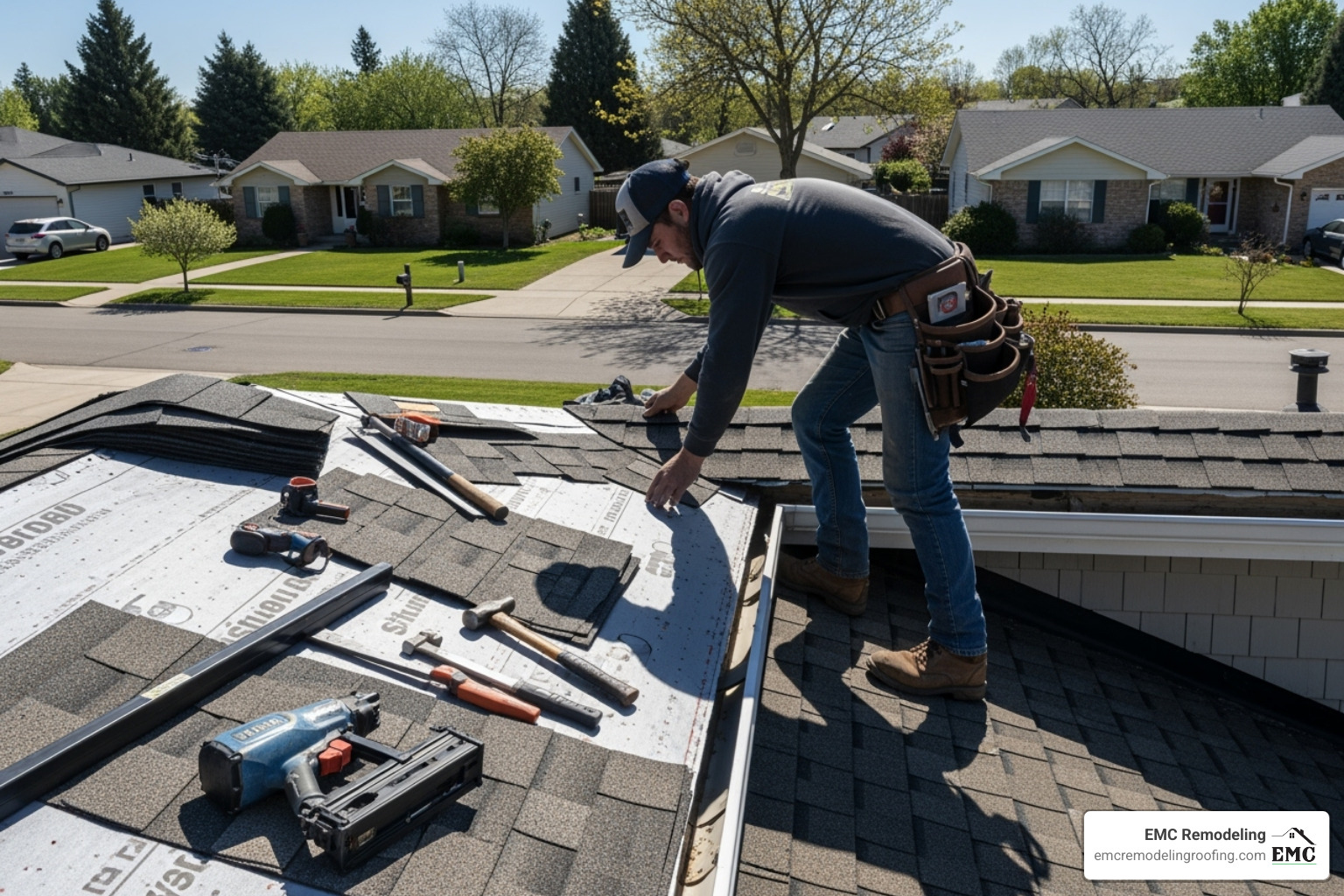
Consider calling a professional if you encounter:
- Widespread Rot: If decay affects large sections of fascia, soffit, or multiple rafter tails, a professional is needed to ensure all compromised wood is removed without affecting structural integrity.
- Structural Damage: Any sagging, bowing, or compromised rafter tails are serious issues that require an expert to prevent dangerous structural failures.
- Safety Concerns: If you are uncomfortable with heights, lack proper safety equipment, or don’t have a spotter, it is safer to hire a professional with the right gear and experience.
- Time Commitment: Major eave repairs can be time-consuming. A professional can complete the job efficiently, saving you time and hassle.
| Feature | DIY Repair | Professional Repair |
|---|---|---|
| Cost | Lower material cost (Basic DIY: ~$150) | Higher initial cost, but long-term value may be better |
| Time | High time commitment, learning curve | Efficient, quicker completion |
| Warranty | None | Often comes with workmanship warranties |
| Safety | Significant risks (heights, electrical) | High safety standards, specialized equipment |
| Quality | Variable, depends on skill and experience | Consistent, high-quality craftsmanship, proper techniques |
| Expertise | Basic knowledge, learning as you go | Specialized knowledge of roofing systems, underlying issues |
Benefits of Professional Repair
Choosing a professional offers significant advantages. Their expertise ensures they identify the root cause of the damage, not just the symptoms, leading to a more durable repair. Professionals provide workmanship warranties, giving you peace of mind. They can also assist with insurance claims if the damage is from a covered event. Using high-quality materials and adhering to strict safety protocols, a professional ensures the job is done correctly and safely the first time.
Your Local Eave Repair Experts in Temple, TX
For extensive damage or if you’re unsure about tackling the project, a professional can ensure the job is done right.
Name: EMC Remodeling
Address: 5100 Midway Dr Suite 211, Temple, TX 76502
Phone: (254) 760-9268
As a family-operated business, we understand the importance of protecting your home. Our direct owner involvement means every roof eaves repair project gets the attention it deserves. We’re not just contractors; we’re your neighbors, committed to keeping Central Texas homes safe and dry.
Frequently Asked Questions about Roof Eaves Repair
Homeowners often have similar questions when dealing with eave issues. Here are answers to some of the most common ones.
What is the difference between eaves, soffits, and fascia?
These three terms describe different parts of a single system:
- Eaves: The general term for the roof’s overhang that extends beyond the exterior walls.
- Soffit: The horizontal underside of the eave, which often contains vents for attic airflow.
- Fascia: The vertical board that faces outward along the roof’s edge, where gutters are attached.
Together, they protect your home from water, provide ventilation, and give your roofline a finished look.
How much does it cost to repair roof eaves?
The cost of roof eaves repair depends on the extent of the damage.
- DIY Minor Repairs: Material costs for small fixes like filling cracks can be under $150.
- Professional Repairs: The average cost for professional work ranges from $460 to $1,330. A typical project, like replacing a 30-foot section of soffit and fascia, costs around $900. Fascia and soffit replacement both typically cost $15-$30 per linear foot.
While DIY is cheaper upfront, professional repairs often include warranties and ensure the underlying issues are properly addressed.
How can I prevent future eave damage?
Preventive maintenance is the best way to avoid costly repairs. Key steps include:
- Regular Gutter Cleaning: Clean your gutters at least twice a year to prevent clogs and water overflow that can damage eaves.
- Annual Roof Inspections: A professional inspection can identify early signs of trouble like loose flashing, small cracks, or rot before they become major problems.
- Ensure Proper Attic Ventilation: Check that soffit vents are not blocked by insulation, as proper airflow is crucial to prevent moisture buildup and rot.
- Address Small Issues Immediately: Promptly fix peeling paint or seal small cracks. A tube of caulk and some touch-up paint can prevent hundreds of dollars in future repairs.
Protect Your Home by Protecting Your Eaves
Your roof eaves are the unsung heroes of your home’s protection system. They work tirelessly to channel water away from your foundation, ventilate your attic, and maintain your home’s structural integrity.
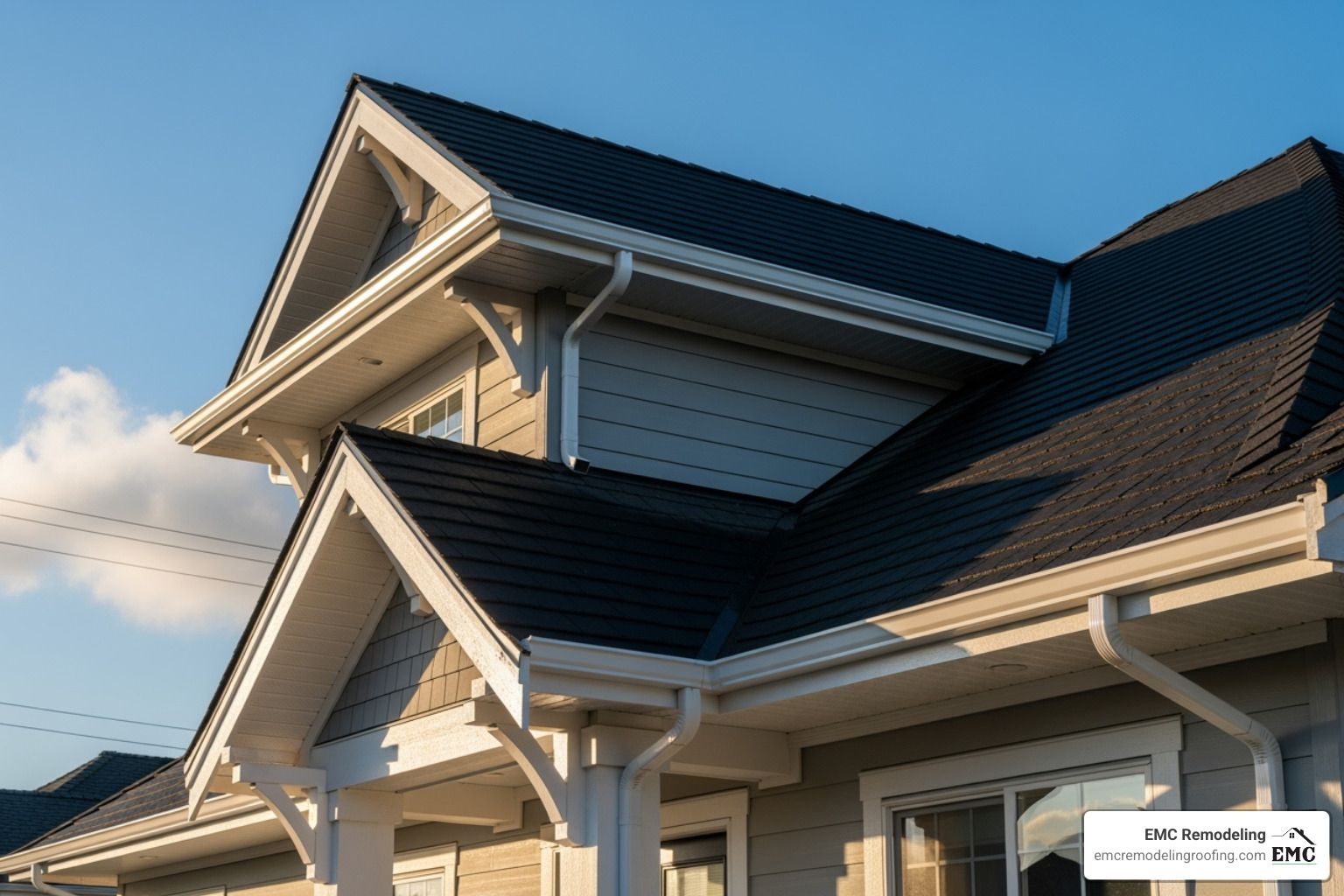
Roof eaves repair is more than fixing a broken board; it’s about safeguarding your entire home. A small issue left unchecked can lead to widespread rot and thousands in structural damage. You are now equipped to spot problems early and take action.
For minor issues, you have the knowledge to perform a DIY repair. For bigger challenges—widespread rot, structural concerns, or anything that makes you uncomfortable working at height—calling a professional is a smart investment in your home’s future.
At EMC Remodeling, we’ve seen how proactive eave maintenance protects homes, keeps energy bills manageable, and provides homeowners with peace of mind. Don’t wait for minor issues to become major headaches. For a professional assessment and a lasting solution, contact us for all your roof repair needs. We are your trusted partner in keeping your home safe, dry, and beautiful.
